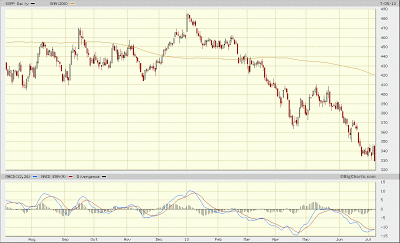Long-term FX winners and losers
While I love looking at stocks and shares, particularly since November of last year which has been kind to the equity investor, I have also been tracking a combination of different macro trends have thrown up a number of clear, long-term trends in FX.
The Greenback: Setting off on a bull run!
A backdrop of improving macroeconomic trends (unemployment, housing, retail sales) combined with the belief that the Fed will finally start to put a very gentle brake on their rash of bond buying, is the backdrop for a strengthening US dollar. The US dollar index (chart below) has responded to these trends by rocketing up the currency charts over the last few weeks, adding 5% in this very short time window.
 |
| US Dollar Index Hits a 12-Month High! |
While you may start to worry about potentially buying the US dollar at the top, note that there is still a fair way to go before the US dollar index reaches multi-year highs...
 |
| 5-Year Peak For USD Was Around 89, vs. 84.6 now |
The Loonie is also worth watching...
Now while the Canadian dollar has been a strong currency for quite a while now, note that the recent trend for the Loonie has been a weakening rather than strengthening, at least against its Southern neighbour:
 |
| US Dollar Has Strengthened Against CAD Since Sept. 2012 |
But that being said, the Loonie should be aided by stronger Canadian export performance (thanks to current FX weakness) and of course the follow-through from a stronger US economy (the Canuck's biggest trading partner by far) and higher oil prices (they are a big oil producer thanks to oil sands).
Note that the Canadian bank CIBC is predicting that the Loonie could return to parity against the Greenback by the end of 2014 (CIBC's Monthly FX Outlook - June 2013), suggesting that it should remain a stronger currency within the G10 currencies (the 10 most heavily-traded currencies).
Can the Aussie Dollar Slide Even Further? Could be...
The two key drivers for a weaker Australian dollar have been:
(a) a clear slowing in the Chinese economy growth rate, impacting demand for Australian-sourced commodities like iron ore, coking coal and copper, and
(b) The Reserve Bank of Australia cutting interest rates, now down to 2.75%:
 |
| Australian interest rates have been cut several times recently |
Now hardly surprisingly, given the worries over the Chinese slowdown impacting Australian commodity exports and lower interest rates also making the Aussie dollar less attractive, the AUD has slid quite dramatically against most currencies since the beginning of April this year.
However, looking at a 5-year chart, it would seem evident that the AUD could yet weaken quite a bit further, since the 5-year low for AUD/USD was 0.62 versus 0.92 now.
 |
| A very long way for the Aussie dollar to go to plumb 5-year lows |
I think that the major risk for the Australian economy (and by extension its currency) remains that of a greater-than-anticipated slowdown in Chinese economic growth. For now, financial markets seem to be happy with the idea that the Chinese government will slow the economy just enough to curb inflation and manage the transition from an investment-led to consumer-led economy. I would suggest that this perception could change quite quickly, and potentially lead to the AUD weakening further from here.
Abenomics continues to weigh on the Yen
A key plank of the Japanese government's reflation effort for their economy rests on weakening the Yen sufficiently to stimulate the country's car, industrial and technology exporters to drive growth. The Bank of Japan seems similarly determined to continue to add monetary stimulus in the form of buying financial assets (not just bonds, but potentially also stocks), all of which argues for a yet weaker Yen.
After a short period when the Yen reversed its weakening trend against all other G10 currencies, we are now back to a steadily weaker Yen once again as the BoJ are expected to expand their Quantitative Easing program, just as the US Fed are supposedly going to start pulling back gently on theirs.
 |
| Yen has resumed its weakening trend against the US dollar |
Conclusion: USD and CAD set to gain ground, weaker AUD and JPY in prospect
I think there will be a number of opportunities in the months ahead to go long both the USD and CAD against the AUD and JPY, extending the trends that have already been in place for some time now. Never underestimate the ability of a financial market trend to persist for longer than you can possibly imagine...
Edmund










